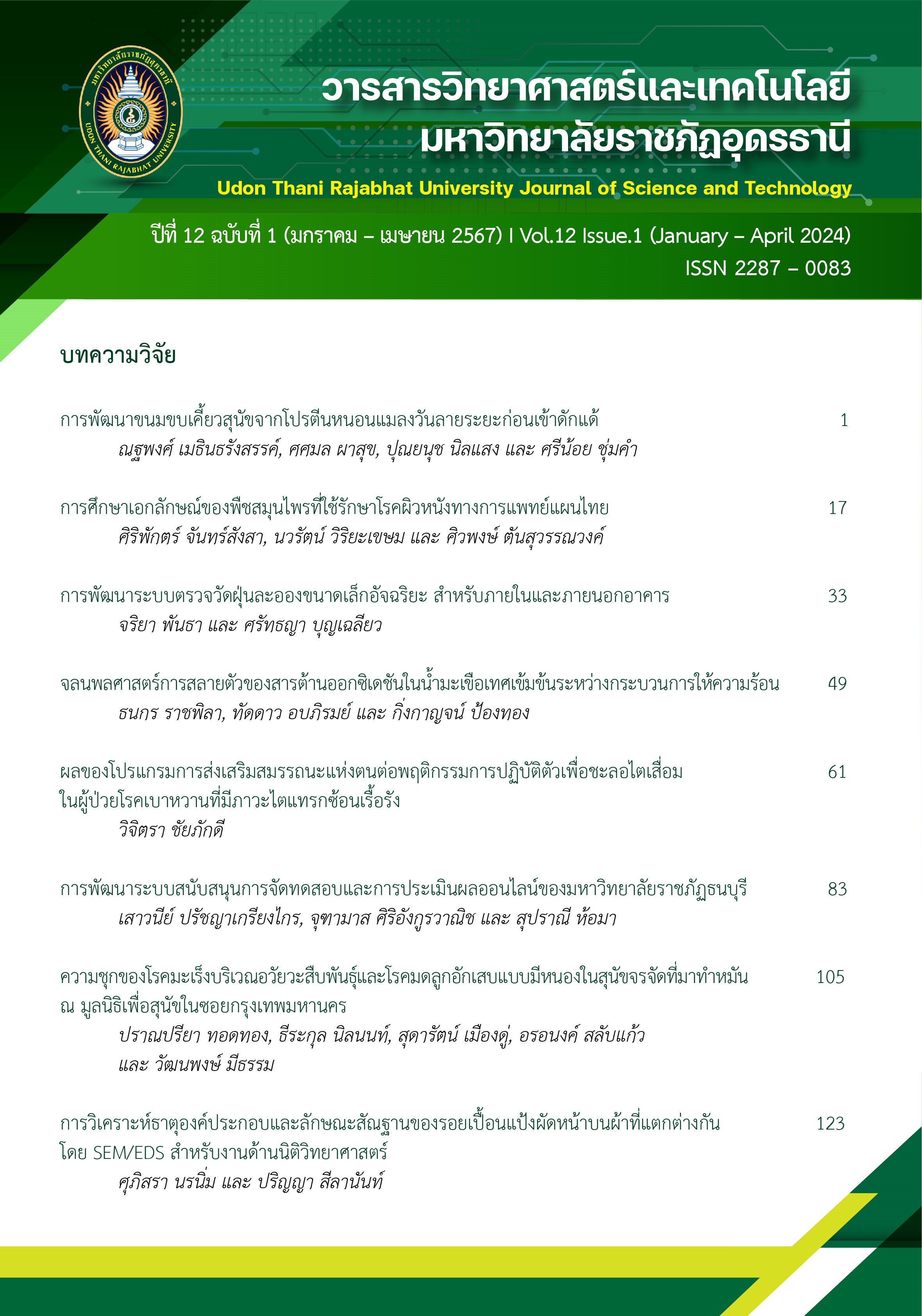ผลของโปรแกรมการส่งเสริมสมรรถนะแห่งตนต่อพฤติกรรมการปฏิบัติตัว เพื่อชะลอไตเสื่อมในผู้ป่วยโรคเบาหวานที่มีภาวะไตแทรกซ้อนเรื้อรัง
Main Article Content
บทคัดย่อ
การวิจัยกึ่งทดลองแบบกลุ่มเดียววัดก่อนหลัง มีวัตถุประสงค์เพื่อศึกษาผลของโปรแกรมการส่งเสริมสมรรถนะแห่งตนต่อพฤติกรรมการปฏิบัติตัวเพื่อชะลอไตเสื่อมในผู้ป่วยโรคเบาหวานที่มีภาวะไตแทรกซ้อนเรื้อรัง กลุ่มตัวอย่างคือผู้ป่วยเบาหวานชนิดที่ 2 ที่มีภาวะไตเสื่อมระยะที่ 3 ที่เข้ารับการรักษาที่โรงพยาบาลสมเด็จพระยุพราชธาตุพนม จำนวน 44 ราย ทำการสุ่มตัวอย่างอย่างง่าย เครื่องมือที่ใช้ในการศึกษาได้แก่ โปรแกรมการส่งเสริมสมรรถนะแห่งตนต่อพฤติกรรมการปฏิบัติตัวเพื่อชะลอไตเสื่อมในผู้ป่วยโรคเบาหวานที่มีภาวะไตแทรกซ้อนเรื้อรัง ทำการศึกษาทั้งหมด 8 สัปดาห์ เก็บข้อมูลด้วยแบบสอบถาม วิเคราะห์ข้อมูลด้วยความถี่ ร้อยละ ค่าเฉลี่ย ส่วนเบี่ยงเบนมาตรฐานและ Paired sample t-test ผลการ ศึกษาพบว่า กลุ่มตัวอย่างส่วนใหญ่เป็นเพศชาย ร้อยละ 52.27 มีอายุ 61 ปีขึ้นไป ร้อยละ 43.18 สำเร็จการศึกษาประถมศึกษาหรือน้อยกว่า ร้อยละ 36.36 ประกอบอาชีพเกษตรกร ร้อยละ 47.73 มีรายได้อยู่ระหว่าง 5,001-10,000 บาท ร้อยละ 56.82 ระยะเวลาที่ป่วยด้วยโรคเบาหวาน 7-10 ปี ร้อยละ 36.36 ค่าคะแนนเฉลี่ยความรู้เรื่องโรคไตเรื้อรัง การรับรู้สมรรถนะแห่งตนเพื่อชะลอการเสื่อมของไต พฤติกรรมการปฏิบัติตัวเพื่อชะลอไตเสื่อม และค่าระดับอัตราการกรองของไตหลังการทดลองแตกต่างจากก่อนการทดลองอย่างมีนัยสำคัญทางสถิติที่ระดับ p<0.05 จากการศึกษาครั้งนี้มีข้อเสนอแนะดังนี้ เจ้าหน้าที่สาธารณสุขในพื้นที่สามารถนำโปรแกรมการส่งเสริมสมรรถนะแห่งตนต่อพฤติกรรมการปฏิบัติตัวไปใช้เป็นแนวทางในการให้สุขศึกษาในผู้ป่วยโรคเรื้อรังอื่นๆเพื่อให้ผู้ป่วยมีผลลัพธ์ทางคลินิกที่ดีต่อไป
Article Details
References
กมลทิพย์ วิจิตรสุนทรกุล. (2565). ระบาดวิทยาและการทบทวนมาตรการป้องกันโรคไตเรื้อรัง. นนทบุรี: กระทรวงสาธารณสุข.
กระทรวงสาธารณสุข. (2564). จำนวนผู้ป่วยโรคไตเรื้อรังที่มารับบริการที่โรงพยาบาล จำแนกตาม Stage (Work Load). สืบค้นเมื่อวันที่ 30 ตุลาคม 2566, จาก https://hdcservice.moph.go.th/hdc/reports/report.php?&cat_id=e71a73a77b1474e63b71bccf727009ce&id=47a33f6886e36962dec4bb578819ba64.
กระทรวงสาธารณสุข. (2565). จำนวนผู้ป่วยโรคไตเรื้อรังที่มารับบริการที่โรงพยาบาล จำแนกตาม Stage (Work Load) จังหวัดนครพนมโรงพยาบาลสมเด็จพระยุพราชธาตุพนม ปีงบประมาณ 2565. สืบค้นเมื่อวันที่ 30 ตุลาคม 2566, จาก https://hdcservice.moph.go.th/hdc/reports/report.php?&cat_id=e71a73a77b1474e63b71bccf727009ce&id=47a33f6886e36962dec4bb578819ba64.
ขวัญเรือน แก่นของ, ศิริรัตน์ อนุตระกูลชัย, สุณี เลิศสินอุดม และ อัมพรพรรณ ธีรานุตร. (2562). ผลของโปรแกรมการส่งเสริมพฤติกรรมสุขภาพต่อพฤติกรรมการปฏิบัติตัวเพื่อชะลอการเสื่อมของไตในผู้ป่วยโรคไตเรื้อรังระยะที่ 1-3a. วารสารการพยาบาลและการดูแลสุขภาพ 2562, 37(3), 211-220.
จันจิรา หินขาว, ขนิตฐา หาญประสิทธิ์คำ และ สุนทรี เจียรวิทยกิจ. (2562). ผลของโปรแกรมการจัดการตนเองร่วมกับการสัมภาษณ์เพื่อสร้างแรงจูงใจเพื่อชะลอไตเสื่อมจากเบาหวานต่อพฤติกรรมการจัดการตนเองและผลลัพธ์ทางคลินิกในผู้ป่วยเบาหวานชนิดที่ 2 ที่มีความเสื่อมของไตระยะที่ 3. วารสารวิทยาลัยพยาบาลพระปกเกล้า จันทบุรี, 30(2), 185-202.
ชญานิศ ศุภนิกร, วีณา เที่ยงธรรม และ เพลินพิศ บุณยมาลิก. (2562). โปรแกรมการประยุกต์ทฤษฎีแรงจูงใจในการป้องกันโรคเพื่อส่งเสริมพฤติกรรมชะลอความเสื่อมของไตในผู้ป่วยไตเรื้อรังระยะที่ 3 ในชุมชน. วารสารพยาบาลกระทรวงสาธารณสุข, 29(2), 165-177.
ธำรง ทองสง่า. (2563). ผลของโปรแกรมการดูแลผู้ป่วยไตเรื้อรังระยะที่ 3 ในคลินิกชะลอไตเสื่อมโรงพยาบาลบางปะอิน. วาสารสมาคมเวชศาสตร์ป้องกันแห่งประเทศไทย, 10(3), 397-412.
นฤมล สบายสุข. (2561). ผลของโปรแกรมสนับสนุนการจัดการตนเองต่อพฤติกรรมสุขภาพและอัตราการกรองของไตในผู้ป่วยเบาหวานชนิดที่ 2 ที่มีภาวะไตเรื้อรังระยะที่ 3. (วิทยานิพนธ์ปริญญาพยาบาลศาสตรมหาบัณฑิต มหาวิทยาลัยนเรศวร).
ปริยากร วังศรี, วีนัส ลีหฬกุล และ ทิพา ต่อสกุลแก้ว, 2559. ผลของโปรแกรมการส่งเสริมการรับรู้สมรรถนะแห่งตนในการควบคุมภาวะไตเสื่อมในผู้ป่วยเบาหวานชนิดที่ 2. วารสารวิทยาลัยนครราชสีมา, 10(2), 98-110.
เพ็ญศรี จิตต์จันทร์, ธีรนุช ยินดีสุข และ อินทนิล เชื้อบุญชัย. (2562). ผลของการใช้รูปแบบการดูแลผู้ป่วยโรค เรื้อรังต่อการชะลอการเสื่อมของไต ตำบลหนองขอน จังหวัดอุบลราชธานี. วารสารพยาบาลทหารบก, 20(2), 251-261.
รัญชนา หอมสุวรรณ. (2561). ผลของการใช้โปรแกรมชะลอไตเสื่อม ในผู้ป่วยเบาหวาน ศูนย์สุขภาพชุมชนเมือง โรงพยาบาลพระนารายณ์มหาราช สาขาเทศบาลตำบลทาศาลา. โรงพยาบาลสิงห์บุรีเวชสาร, 27(1), 55-64.
ศิริวรรณ พายพัตร, น้ำอ้อย ภักดีวงศ์ และ วารินทร์ บินโฮเซ็น. (2564). ความสัมพันธ์ระหว่างความรู้และการรับรู้สมรรถนะแห่งตนกับพฤติกรรม การจัดการตนเองในผู้ป่วยโรคไตเรื้อรัง. วารสารการพยาบาลและสุขภาพ สสอท, 3(2), 22-36.
สุภาพ สุทธิสันต์ชาญชัย และ อรสา โอภาสวัฒนา. (2564). ประสิทธิผลของโปรแกรมชะลอไตเสื่อมในผู้ป่วยโรคไตเรื้อรัง ระยะที่ 3 ของคลินิกโรคไตเรื้อรัง โรงพยาบาลอู่ทอง จังหวัดสุพรรณบุรี. วารสารแพทย์เขต 4-5, 40(2), 255-267.
อารีย เพ็ญสุวรรณ และ บุษบา บัวผัน. (2564.) ผลการจัดการตนเองเพื่อชะลอไตเสื่อม สำหรับผู้ป่วยเบาหวานชนิดที่ 2 ในชุมชนโรงพยาบาลส่งเสริมสุขภาพตำบลบ้านแซงแหลม จังหวัดร้อยเอ็ด. วารสารวิจัยและพัฒนานวัตกรรมทางสุขภาพ, 2(2), 213-224.
Bandura, A. (1997). Self-efficacy: The exercise of control. New York: W. H. Freeman.
Best, J. W. (1981). Research in Education, 4th ed. New Jersey: Prentice- Hall Inc.
Hogan, M. (2009). KDIGO conference proposes changes to CKD classification, but not to the definition. Nephrology Times, 2(12), 9-10.
KDIGO. (2013). KDIGO 2012 Clinical Practice Guideline for the Evaluation and Management of Chronic Kidney Disease. Kidney InternationalSupplements, 3(1), 1-13.
Rumeyza, K. (2013). Risk Factors for Chronic Kidney Disease: an update. Kidney International Supplements, 3(4), 368-371.
Shrestha, N., Gautam, S., Mishra, S.R., Virani ,S.S., & Dhungana, R.R. (2021). Burden of chronic kidney disease in the general population and high-risk groups in South Asia: A systematic review and meta-analysis. PLoS One, 16(10), 1-19.

